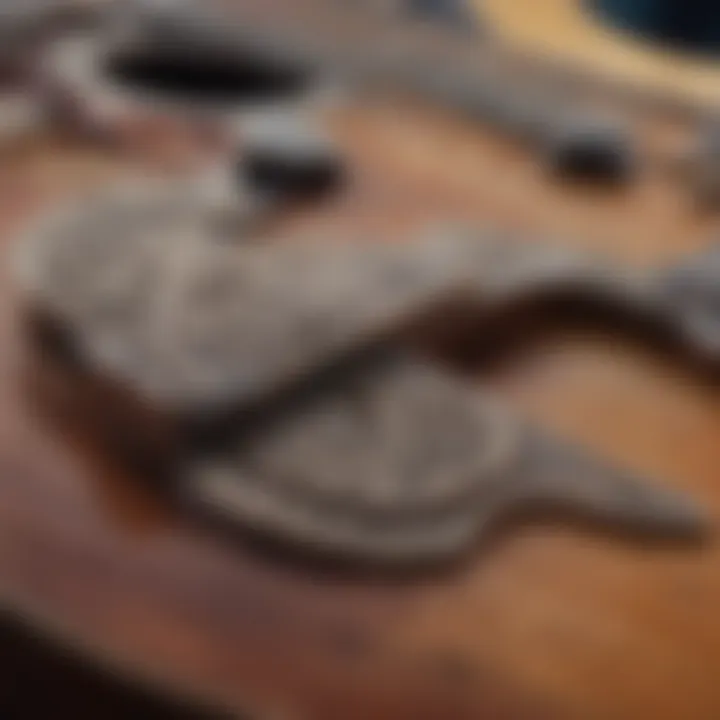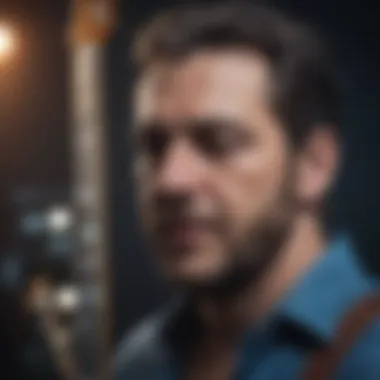The Evolution and Impact of Blues Guitarists


Intro
Blues guitarists have had a profound impact on music, transcending genres and influencing countless musicians. Their unique styles and techniques laid the groundwork for modern music. The evolution of blues guitarists is a story of cultural significance, technical progression, and emotional depth. This exploration will underscore how blues guitarists not only shaped the blues genre but also contributed to a rich tapestry of music history.
Artist Profile
Biography and Background
Many blues guitarists emerged from humble beginnings, often in rural areas of the Southern United States. They grew up in an environment rich with musical traditions, finding inspiration in African-American spirituals and folk music. The stories of legendary figures like B.B. King, Muddy Waters, and Robert Johnson demonstrate how they faced adversity, yet their passion for music fueled their success. These musicians were often self-taught and learned by ear, developing distinctive techniques that reflected their personal experiences.
Major Influences and Inspirations
The influences on blues guitarists are varied and complex. Early musicians drew from the rich traditions of African music, incorporating call-and-response patterns and improvisation. Popular music, gospel, and jazz also played pivotal roles in shaping their sound. The Delta blues style, characterized by slide guitar and fingerpicking, highlighted the emotional aspects of their music. Influences from artists like Son House and Charlie Patton can be seen in the works of later blues guitarists, further enriching the genre.
"The blues is a healing thing. It's something that can reach into the depths of despair and pull out something beautiful."
— B.B. King
Song Analysis
Theme and Lyrics Breakdown
Themes in blues music often revolve around struggle, heartache, and resilience. Lyrics reflect personal experiences, painting portraits of life's challenges. These narratives connect to universal human emotions, making the music relatable across cultures. The storytelling aspect invites listeners to engage more deeply with the artist's journey.
Instrumentation and Composition
Instrumentation in blues music primarily revolves around the guitar, but also includes piano, harmonica, and bass. The guitar techniques vary widely, from fingerstyle to flatpicking. Chord progressions often follow the twelve-bar blues format, creating a familiar structure that allows for improvisation. Contemporary blues guitarists continue to experiment with these elements, mixing traditional sounds with modern influences.
This exploration of blues guitarists not only highlights their contributions to music but also underscores the ongoing evolution of the genre. As we move forward, it is essential to understand their legacy and the cultural significance they hold.
Historical Context of the Blues
The historical context of blues music plays a fundamental role in understanding not just the genre itself but also the evolution of blues guitarists. Recognizing the social, economic, and cultural landscapes of the time period provides vital insights into how the blues emerged. Blues was formed in the post-Civil War South, shaped largely by the experiences of African Americans. This music served as a reflection of the hardships they endured and the rich traditions they brought.
So, what elements are critical to finding the essence of blues guitarists? First, it's important to look at the roots of the genre. The blues is often characterized by its emotional depth, which is the result of a long history of struggle and resilience. The challenges faced by early African American communities led to a need for expression, which seamlessly transitioned into musical forms.
Moreover, the influence of African musical traditions is evident in the use of call-and-response patterns, rhythmic complexity, and improvisation. All these aspects contributed to the curated styles of blues guitarists. Key figures would emerge in this landscape, but they were all connected through a shared history and lineage of musical expression.
In essence, exploring this historical context is crucial for grasping the full impact that blues guitarists have had. It not only identifies the roots of their techniques but also illustrates how their music became a powerful voice of cultural commentary. For anyone delving into this topic, understanding the origins and influences adds rich layers to the narrative of blues guitar history.
Origins of Blues Music
The origins of blues music can be traced back to the late 19th and early 20th centuries. It began as a rural African American folk music form primarily in the Mississippi Delta region. The fusion of African traditions with European musical styles laid the groundwork for what would evolve into the blues genre.
Musicians would often perform in juke joints or alongside work fields, contributing to a communal social environment. Instruments, predominantly the guitar, were typically simple and accessible. This allowed for a wider dissemination of the music as people could easily learn to play.
The musical structure of blues is predominantly based on a twelve-bar format, which emphasizes the repetition of musical phrases.
"The blues is a powerful expression of life that transcends the surface of mere notes and melodies."
As the blues grew, it started to incorporate personal stories, spirituals, and labor songs. This lyrical content was deeply rooted in the experiences of the African American struggle. The themes of heartache, despair, and hope allowed listeners to connect emotionally. With each strum of the guitar, there was a narrative unfolding that transcended simple music.
Social and Cultural Influences
The social and cultural influences that shaped the blues cannot be overlooked. The blues arose from a complex tapestry of African American history. Factors such as migration, urbanization, and socio-economic shifts played significant roles. After the Great Migration, where many African Americans moved from the South to Northern cities, blues began to adopt new influences.
In urban centers, the introduction of electric instruments opened fresh possibilities for sound. Artists adapted their talents, creating distinctive styles that resonated with new audiences.
Folk traditions and spirituals mixed with urban jazz and ragtime, leading to the birth of various blues subgenres. The music became a way to articulate the joys and sorrows tied to their lives.
Additionally, social issues like racism and poverty informed the lyrics and themes of many blues songs. This made blues not just a musical style but a powerful form of social commentary. It was a genre that spoke honestly to the struggles of everyday life, making it timeless and relevant.
These historical perspectives provide a foundation for understanding the evolution of blues guitarists. Their contributions stem from a rich tradition rooted in real experiences and ongoing sociocultural dialogues.
Defining Characteristics of Blues Guitar Playing
Understanding the defining characteristics of blues guitar playing is essential for comprehending its cultural influence and technical nuances. Blues guitarists have developed a unique sound that captures emotional depth and technical precision. Each element contributes to the tapestry of blues music, providing aspiring musicians with techniques that can be applied across genres. A keen exploration into this subject reveals its significance in preserving the art of blues guitar while also encouraging innovation.


Emotional Expression in Guitar Solos
Emotional expression within guitar solos is at the heart of blues music. This style prioritizes feelings over pristine technical execution. A well-crafted solo often tells a story or expresses a sentiment that resonates deeply with listeners. Guitarists achieve this by utilizing techniques such as bends, slides, and vibrato which convey pain, joy, or nostalgia. The authenticity of these expressions invites the audience into a shared experience, bridging the gap between the performer and the listener. Mastery of emotional expression is often what distinguishes a mediocre performance from a memorable one.
Essential Techniques Used in Blues
In blues guitar, various techniques enhance its distinct sound. Each technique serves a purpose and adds texture to the music. Understanding these techniques is crucial for aspiring blues musicians.
Bending Notes
Bending notes is a critical technique in blues guitar that enhances musical expressiveness. It involves pushing the string across the fretboard to raise the pitch. This technique allows players to create a crying or pleading quality often associated with the genre. It’s a favored choice among guitarists because it mimics the human voice, making it particularly compelling.
The unique feature of bending notes lies in its ability to express subtle emotions. The challenge, however, is achieving the right pitch. If not executed well, a bent note can sound out of place.
Sliding
Sliding is another foundational technique in blues guitar. It involves gliding from one fret to another, creating a smooth transition between notes. This technique contributes to the fluidity of solos, adding an elegant flair to the music. Guitarists often use slides to shift between different tonalities, enriching the sound.
The main characteristic of sliding is its seamless nature, making it a preferable choice in blues solos. The advantage of this technique is its ability to link phrases together beautifully. However, it requires precision to ensure a clear sound; otherwise, it can sound muddy.
Fingerpicking
Fingerpicking in blues guitar involves using fingers instead of a pick to pluck the strings. This method provides greater control over dynamics and articulation, allowing for a distinct sound. Many traditional blues guitarists, like Delta blues artists, often employed fingerpicking to create intricate patterns.
The key aspect of fingerpicking is its versatility. It enhances the ability to combine melody and rhythm simultaneously. For many players, it is a beneficial choice as it adds depth and complexity to the performance. The downside, however, is that mastering this technique requires patience and consistent practice, which may deter some beginners.
Pioneering Blues Guitarists
The era of pioneering blues guitarists marks a significant chapter in the understanding of blues music. These musicians laid the groundwork for not just blues, but genres that followed. Their creative expressions and technical innovations have shaped the way guitar is played in a variety of contexts. Their importance cannot be overstated, as they infused emotional depth and storytelling into their music. Here we reflect on three monumental figures in blues history: Robert Johnson, Muddy Waters, and B.B. King.
Robert Johnson: The Myth and Legacy
Robert Johnson is often regarded as a foundational figure in blues music. His life and career, although short, resonate deeply within the genre. Born on May 8, 1911, in Hazlehurst, Mississippi, he became renowned for his exceptional fingerpicking technique and haunting lyrics.
Johnson's story includes legends of a pact with the devil, which contributes to his mythic status. His songs like "Cross Road Blues" and "Hellhound on My Trail" illustrate themes of despair, longing, and veneration that many artists continue to draw upon. His unique blend of Delta blues can be heard influencing numerous musicians through the decades.
In examining Johnson’s technique, one might focus on his use of alternate tunings and innovative chord progressions. He utilized these choices to convey rich emotions, making his a powerful influence in modern music. The totality of his work remains a pillar for blues guitarists looking to connect with the tradition.
Muddy Waters: The Chicago Sound
Muddy Waters fundamentally transformed blues music during the mid-20th century. Born McKinley Morganfield on April 4, 1913, in Mississippi, he later moved to Chicago, where he became a central figure in the urban blues movement. His electric guitar sound redefined the genre and set the stage for rock-and-roll.
Waters's use of amplification brought a new energy, and his songs like "Hoochie Coochie Man" and "Mannish Boy" captured the essence of a vibrant cultural transformation. His powerful voice combined with his guitar prowess created a blueprint for countless artists.
Additionally, his collaborations with talented musicians such as Buddy Guy and Little Walter showcased the integration of Chicago blues styles into the mainstream. His legacy endures through modern artists who continue to honor his contributions while expanding the genre.
B.B. King: The Thrill is Here
B.B. King, often referred to as the “King of Blues,” elevated the role of the guitar in blues music. Born on September 16, 1925, in Itta Bena, Mississippi, he became one of the most influential musicians in American history. King's phrasing and vibrato set a standard which impacted countless guitarists globally.
His famed guitar, "Lucille," became an extension of his artistic voice. Songs like "The Thrill Is Gone" demonstrate his mastery of blending soulful lyrics with intricate guitar solos. King’s ability to convey emotion through his instrument earned him critical acclaim and commercial success.
He was instrumental in bringing blues into larger venues, playing for audiences that had previously not been exposed to the genre. His impact can be seen in diverse genres, showing the far-reaching influence of his style.
"Muddy Waters and B.B. King not only shaped the sound of blues but created pathways for future generations of musicians to explore their craft."
In summary, the contributions of these pioneering guitarists provide invaluable insights into the evolution of blues music. Each artist, with their distinct style and approach, not only defined their era but also left indelible marks on the broader music landscape. Their legacies continue to inspire new waves of reality in both aspiring musicians and seasoned experts alike.
Modern Blues Guitarists
The landscape of blues guitar has evolved significantly over the decades, and modern blues guitarists are at the forefront of this transformation. Their contributions are crucial, as they blend traditional blues elements with contemporary sounds and techniques, ensuring that blues remains relevant and vibrant in today's music scene. Modern artists not only pay homage to their predecessors but also expand the boundaries of the genre. In this section, we will explore key figures who are shaping the modern blues scene, detailing their unique styles, influences, and the impact they have on both audiences and aspiring musicians.
Stevie Ray Vaughan: Reviving the Genre
Stevie Ray Vaughan is a defining figure in modern blues guitar. His intensity and passion breathed new life into the genre during the 1980s. Vaughan combined Texas blues with rock vibes, creating a sound that was both nostalgic and innovative.


Vaughan's guitar playing was characterized by his fierce use of string bending, a technique that evokes deep emotion. He often performed with a heavy-handed approach, making the guitar sing with a voice all its own. His skills were showcased in renowned tracks like "Pride and Joy" and "Texas Flood." Vaughan's live performances were legendary, leaving audiences spellbound.
This revitalization of blues music brought back attention to the genre. Vaughan inspired a new generation of guitarists to pick up the guitar and delve into the blues. His recordings and performances brought authenticity back, demonstrating the genre's emotional depth and technical complexity.
Joe Bonamassa: The New Blues Sensation
Joe Bonamassa is another pivotal figure in modern blues. He is well known for his high-energy performances and original compositions that keep the spirit of blues alive. Bonamassa's ability to infuse blues rock with elements of jazz and folk illustrates his versatility as a guitarist. His tireless work ethic and prolific output have earned him a dedicated following.
With albums like "Blues of Desperation" and "Dust Bowl," Bonamassa showcases his impressive fingerstyle technique and mastery of guitar tone. He expertly blends traditional blues with contemporary influences, making his music accessible to a broad audience. This balance between tradition and innovation is what sets him apart in the music industry today.
Bonamassa also dedicates efforts to music education, conducting workshops and providing resources for aspiring musicians. His engagement with young artists further solidifies his role as a modern blues ambassador, shaping the future of the genre.
Keb' Mo': A Unique Blend of Styles
Keb' Mo' offers a distinctive perspective on modern blues. His music transcends traditional blues boundaries, incorporating elements from folk, rock, and even pop. This eclectic mix not only refreshes the blues sound but makes it appealing to a wider audience.
Keb' Mo's heartfelt storytelling is a hallmark of his songwriting. Tracks like "Am I Wrong" and "Just Like You" reveal profound emotional depth while highlighting his innovative guitar techniques. His ability to combine slide guitar with fingerpicking creates a unique and accessible sound that resonates with many.
Moreover, Keb' Mo's presence in popular culture brings blues to diverse audiences. He has collaborated with various artists across genres and has even contributed to film and television soundtracks. By blending multiple influences, he preserves the essence of blues while modernizing its appeal, engaging both old fans and newcomers alike.
The skill and passion of modern blues guitarists inspire a new generation, ensuring the legacy of blues music endures through the ages.
Influence of Blues Guitar on Other Genres
The impact of blues guitar on various music genres cannot be overstated. As a foundational element, blues has not only shaped its own genre but also significantly influenced rock, jazz, and country music. Understanding this influence provides valuable insight into how blues guitarists have embedded their styles and techniques into the fabric of contemporary music. While each genre evolved independently, all have drawn inspiration from the emotive power and complex techniques that characterize blues playing. This interchange highlights the versatility of blues guitar and its crucial role in the broader musical landscape.
Transition to Rock Music
The transition from blues to rock music is among the most prominent evolutions in music history. The 1950s saw artists like Chuck Berry and Buddy Holly embrace blues structures, transforming them into rock and roll hits. A defining feature was the use of the twelve-bar blues format, which became a blueprint for countless rock songs. Guitarists like Jimi Hendrix and Eric Clapton further exemplified this shift, infusing blues elements into their rock performances.
Musically, rock captures the raw, expressive solos typical in blues, but with an amplified intensity. The adoption of guitar techniques like bending notes and playing with distortion allowed rock guitarists to channel blues players’ emotional depth while creating a distinct sound. This fusion laid the groundwork for classic rock, punk, and metal genres, where blues guitar influence is evident in both rhythm and solo work.
Integrating Blues into Jazz
Blues has also made significant inroads into jazz music, showcasing an enriching collaboration between the two genres. Artists like Miles Davis and John Coltrane have often incorporated blues elements into their works. The structure of blues provided a strong foundation for improvisation, a hallmark of jazz. This allows musicians to explore complex themes and emotions while maintaining a familiar framework.
Several jazz guitarists, such as Les Paul and Gary Moore, adopted blues techniques, including sliding and fingerpicking. These methods enable a dialogue between the guitarist and the listener, much like a blues solo does. It is this connection that has made the blues a vital part of the jazz idiom. The seamless integration of both styles enhances each genre, showing how versatile and adaptable blues guitar truly is.
Country Music and Blues Crossovers
The crossover between country music and blues is another crucial aspect of blues guitar influence. Artists like Muddy Waters and Hank Williams contributed to a blending of sounds that has inspired many musicians. The storytelling aspect of country lyrics, combined with blues' emotive guitar style, has created a rich tapestry of musical expression.
Traditional techniques such as slide guitar and open tunings typically found in blues have often crossed into country music. These elements create a sound that resonates with both genres' audiences. Modern artists like Kacey Musgraves and Chris Stapleton further reflect this blend, often incorporating blues-inflected guitar into their songs, which expands the audience and appreciation for both styles.
The influence of blues guitar on rock, jazz, and country showcases its versatility and enduring legacy in music.
The Role of Blues Guitar in Music Education
The role of blues guitar in music education is vital in shaping musicians and preserving musical traditions. Blues guitar not only serves as a means of artistic expression but also functions as an educational tool. It connects students with history, cultural heritage, and various techniques that have defined guitar playing. Understanding blues music aids aspiring musicians in developing their craft while appreciating the genre's socio-political context.
Teaching Techniques and Methodologies
Various teaching techniques in blues guitar education focus on practical skills and theoretical understanding. Instructors often use a hands-on approach that emphasizes playing by ear and improvisation. This method enables students to grasp the feel and essence of blues music.
Some common methodologies include:
- Listening Exercises: These are crucial for developing an ear for blues. Students analyze recordings of influential guitarists, allowing them to internalize phrasing, tone, and dynamics.
- Workshops: Group sessions facilitate peer learning. Participants can jam together, exchange ideas, and learn collaboratively. This environment fosters creativity and confidence in performance.
- Transcription: Learning how to read and write music is important, but transcribing solos enhances comprehension. By writing down the notes played by artists like B.B. King or Stevie Ray Vaughan, students deepen their understanding of technique and style.
This combination of methodologies creates a comprehensive learning experience, allowing students to connect with the music in meaningful ways.
Influences on Aspiring Musicians
Blues guitar has a profound impact on aspiring musicians. It encourages technical proficiency and encourages expressive playing that resonates emotionally with audiences. The genre's influence extends beyond blues itself to various styles, including rock, jazz, and country.
Many young musicians find inspiration in the stories told through blues lyrics and melodies. Having role models such as Muddy Waters or Robert Johnson exemplifies the artist's journey, fostering perseverance and artistic dedication.


Moreover, learning blues guitar prepares musicians with skills applicable across genres. Techniques such as bending notes, slide guitar, and fingerpicking are foundational to various musical styles. Some aspiring artists find that mastering blues not only aids their technical skills but also inspires originality in their compositions.
"Blues is a tonic for whatever ails you. I could play the blues, feel the blues, and then the blues would be gone." - B.B. King
Through the lens of blues guitar education, students not only become well-rounded musicians but also custodians of a rich cultural legacy. They learn to interpret and convey emotions through music, making the educational experience holistic and transformative.
Cultural Significance of Blues Guitarists
The cultural significance of blues guitarists can be viewed through several lenses, including their roles as storytellers, agents of change, and educators. The blues genre provided a platform for expressing the struggles and triumphs of life, especially for African Americans in the early 20th century. Guitarists, in particular, have been pivotal in conveying these narratives, often articulating raw emotion in a way that resonates deeply with various audiences.
Blues guitarists emerged not only as musicians but also as cultural icons. Their music often serves as a means of social commentary, addressing issues of race, poverty, and resilience. The impact of their work is felt beyond the music itself, influencing political movements and social discussions around inequality. Therefore, understanding their cultural significance involves recognizing the broader societal implications of their artistry.
Moreover, the music crafted by these guitarists plays an essential role in preserving historical narratives and articulating collective experiences that might otherwise remain unspoken. This aspect of blues guitar playing highlights the importance of these artists in the community and cultural history.
Blues as a Means of Social Commentary
Blues music has long been a means of articulating the lived experiences of a marginalized community. Through powerful lyrics and emotive playing, blues guitarists have addressed social injustices and personal struggles. This tradition of social commentary dates back to the origins of the blues itself, where the music was a response to the harsh realities of life.
Prominent figures like B.B. King and Muddy Waters addressed a range of issues, including systemic racism and economic hardship. Let us consider some key points regarding this aspect:
- Lyrics as Narratives: The lyrics often narrate stories of heartbreak, disenfranchisement, and hope.
- Historical Context: The lyrics reflect the historical experiences of African Americans, shining a light on social issues.
- Performance as Politics: Performances often hold political significance, urging audiences to reflect on the conditions surrounding them.
Blues guitarists use their artistry to provoke thoughts and foster discussions on essential societal topics, effectively using their craft as a vehicle for change. Their music often stirs emotions that lead to a broader awareness and understanding of social challenges.
Preserving Cultural Heritage Through Music
Blues guitarists play a vital role in preserving cultural heritage. The genre itself is steeped in history, rich with the influences of African rhythms, spirituals, and folk traditions. By performing and composing music that draws on these roots, they help to keep this heritage alive.
- Transmission of Tradition: Blues music has evolved, but its core values and traditional elements remain intact, passed from one generation of musicians to another.
- Cultural Identity: For many, the blues represents a significant aspect of cultural identity, connecting them with their heritage and ancestors.
- Educational Influence: Guitarists often share their knowledge through teaching, workshops, and community events, ensuring that the cultural and technical aspects of blues guitar are not lost.
"The blues tells a story about who we are and where we come from, linking the past with the present through each note played."
Exploring Iconic Blues Guitar Tracks
The exploration of iconic blues guitar tracks is foundational to understanding the evolution of blues music itself. These tracks represent a confluence of technical prowess and emotional depth, reflecting not only the skill of the guitarist but also the societal and historical contexts from which they emerged. By analyzing these works, we gain insights into the significant thematic concepts and innovative techniques utilized by blues artists, shedding light on the genre's development over decades.
Key tracks have laid the groundwork for future generations, influencing countless musicians across various genres. The importance of studying these songs lies in recognizing how they encapsulate the essence of the blues: resilience, heartache, and a unique stylistic identity. Additionally, the narratives presented through these tracks often intersect with important cultural movements, providing layers of meaning that go beyond the music itself.
Analyzing Classic Blues Songs
When examining classic blues songs, one can witness both technical mastery and emotional expression. Tracks such as "Cross Road Blues" by Robert Johnson or "Hoochie Coochie Man" by Muddy Waters showcase fundamental elements of blues guitar playing, including call-and-response motifs and the use of pentatonic scales. These songs are not only pivotal in the narrative of the blues genre but serve as essential listening for anyone aspiring to understand and create blues music.
Considering the structure, classic blues songs often follow a 12-bar format, making them accessible for musicians to learn and adapt. This standardized pattern allows artists to express themselves within a familiar framework. Here, techniques like bending notes and sliding into pitches become vital tools for emotional conveyance, enhancing the narrative power of the music. The rhythms and riffs in these songs have influenced rock, jazz, and country, underscoring their importance within the broader musical landscape.
"The blues is a genre steeped in personal expression, rooted deeply in its classic songs.”
Modern Hits with Roots in Blues
Modern music continues to draw upon the rich heritage of the blues, with numerous hits reflecting its influence. Tracks by artists such as Gary Clark Jr. and Joe Bonamassa intertwine traditional blues elements with contemporary sounds, creating new interpretations that resonate with today's audiences.
For example, Gary Clark Jr.'s "Bright Lights" embodies improvisational elements typical of blues guitar, while infusing modern rock sensibilities. Similarly, Joe Bonamassa's songs often feature intricate solos and extended improvisations reminiscent of classic blues guitarists, showcasing how this genre remains relevant. Understanding these modern hits in relation to their blues roots helps to appreciate the ongoing legacy of the genre.
Recognizing these connections allows listeners to see the blues not as a static tradition but as a dynamic influence in modern music, continuing to inspire and shape artistic expression.
The Future of Blues Guitar
The future of blues guitar holds significant relevance in understanding the continuous evolution of the genre. As technology advances, the possibilities for expression and creativity expand. This evolution can redefine the boundaries of blues music, inviting new audiences while honoring its rich heritage. Emerging artists are increasingly blending traditional elements with contemporary influences, which can lead to fresh sounds. The ongoing dynamism within the genre also raises questions about preserving its core essence amid innovation. Maintaining the balance between tradition and modernity is crucial for the genre’s integrity.
Emerging Artists to Watch
Within the landscape of blues guitar, several emerging artists are making waves. Their fresh approaches are often reflective of personal experiences and contemporary issues, connecting deeply with audiences today. Some of these noteworthy talents include:
- Marcus King: His unique blend of rock, soul, and blues captivates listeners, often showcasing intricate guitar work and heartfelt lyrics.
- Shemekia Copeland: A powerful voice in modern blues, Copeland uses her music to address social issues while honoring blues traditions.
- Christone "Kingfish" Ingram: Known for his immense talent at a young age, Ingram is revitalizing blues with his electrifying performances and original compositions.
These artists are not just carrying the torch; they are reshaping the path forward for blues guitar. Their contributions signify a continuation of the genre’s legacy, expanding its reach and relevance.
Technological Innovations in Guitar Playing
Technological advancements are reshaping how guitarists approach blues music. Innovations in gear, digital effects, and recording techniques can significantly enhance the creative process. Here are a few key elements:
- Digital Effects Pedals: Devices such as the Boss Blues Driver or the Electro-Harmonix Holy Grail reverb allow musicians to experiment with sound textures, creating distinctive tones that were previously hard to achieve.
- Software and Recording Technology: Tools like Ableton Live and GarageBand enable artists to record, edit, and produce music from virtually anywhere. Musicians can refine their work and reach a wider audience more easily.
- Online Learning Platforms: Websites like Guitar Tricks and JamPlay provide access to lessons from seasoned professionals. This democratization of knowledge is making blues guitar more accessible to aspiring musicians.
Technological innovations do not only enhance the playing experience but help preserve the blues genre, allowing it to adapt and thrive. As artists embrace these tools, the future of blues guitar seems promising, blending tradition and innovation while reaching new heights.







